Last week, I shared an overview of our July sale in New York. Today, I’m going to look more closely at a few of those instruments and their histories including the Camilli, Gagliano, Schweitzer, Fendt, Carletti and Alf. You can browse the full catalog and bid online now. The sale closes on July 8.
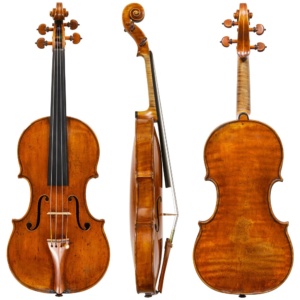
The top lot from our July auction is an exceptional violin by the Mantuan maker, Camillo Camilli, built in circa 1735. Before this violin arrived at William Moennig & Son in the late 1950s, it was attributed first to Pietro Guarneri of Mantua and then later to Tommaso Balestrieri. The former is a reasonable, although clearly opportunistic, call: there were several models used by Camilli and this is his Guarneri model. The large round drill-holes, the tapered wings, the accentuated notches and the short but elegant stems are a close match to the model that Pietro Guarneri began to favor around 1705. The attribution to Balestrieri, however, is more difficult to understand. As Philip Kass, who ran the Moennig shop for many years suggests, it was probably a question of an incremental downgrade. Historically the gap in price between Guarneri and Camilli was larger than the difference in quality between the two makers; Balestrieri fit in as a suitable economic middle ground. Fortunately, the Moennigs recognized this as the work of Camillo Camilli and set the attribution straight before the violin sold it to its current owner in 1960.
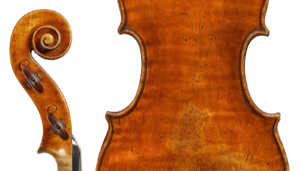
The back is made of a single piece of slab cut maple with original wings in three of the bouts and wide, understated flame throughout. The spruce on the top is laid out atypically with the wide grains at the centre of the instrument. A dendrochronology examination dated the latest measured rings to 1701 and 1705 on the treble and base sides respectively and found significant cross matches with instruments by Pietro Guarneri of Venice, Guarneri ‘del Gesù’, Antonio Stradivari and Giovanni Battista Guadagnini.
The golden orange-brown varnish is the standout feature of this instrument. The color and quality of Camilli’s varnish is unique. If at times it tends too far towards orange and slightly opaque, in this example it is thick and luminous, showing its isolation from the wood by a brighter ground layer.
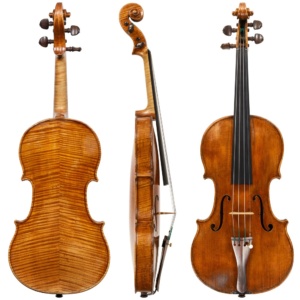
In the 19th and 20th centuries, Neapolitan violin makers excelled at copies and imitations, but ironically the first generations of makers in that city worked almost exclusively on personal models. Alessandro Gagliano used lavish materials and a brilliant reddish orange varnish, but his sound-holes were dramatically swung and often set at an unusually long stop. The classical ‘Gagliano’ model was formalized under Nicolo and although it was a bit more conventional than that of his father, the ‘Nicolo Gagliano’ model was noticeably different from anything being made in the Lombard and Venetian cities of the North. There are, however, some rare, and exceptionally fine copies of Stradivari and Amati made by Nicolo Gagliano such as the Stradivari model violin from c. 1770 in this sale. I have never encountered a Guarneri model Gagliano, let alone anything more esoteric.
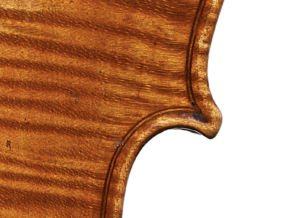
The purfling of Nicolo Gagliano’s Stradivari copies is different from the thin fiber or paper blacks of his normal model
One interesting quirk about Nicolo Gagliano is that his Stradivari copies use a different purfling than that of his normal model. To the uninitiated eye, the purfling and edges on a Strad model by Gagliano can seem Germanic — the blacks tend to fade, the whites are slightly too thin, and the whole ensemble appears too regular. Usually the thin fiber or paper blacks of the purfling of Nicolo Gagliano instruments are an easy give-away, which makes the Stradivari copies all the more surprising.
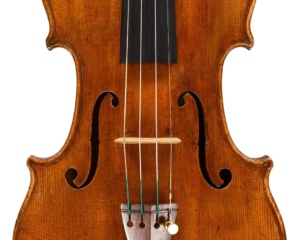
But for being a copy of Strad, it lacks some key features. The sound-holes are typical Nicolo; there are no locating pins to the top or back (almost never in Naples); and the head, which has been thought to be the work of Nicolo’s pupil and collaborator, Giorgio Bairhoff, is a far departure from Cremona. The varnish is also typical of Gagliano: a thin attractive orange top coat over a darker, slightly greenish ground.
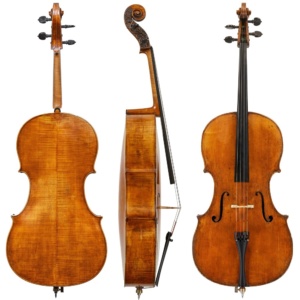
This fine English cello dates from the mid-19th century and is ascribed to the excellent cello maker and copyist, Bernard Simon Fendt. The quality of materials is exceptional, the workmanship first class, but the model is slightly unexpected for Fendt. The 1899 Hill certificate calls this cello a ‘copy of an Italian instrument made sotto la disciplina di Antonio Stradivarius.’ This would suggest it was a copy of one of the late period small-model Stradivari cellos, such as the 1732 ‘Pleeth’ which bears an original ‘sotto la disciplina’ label.
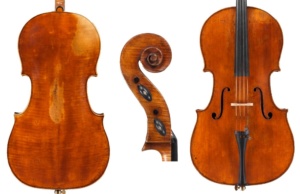
The 1732 ‘sotto la disciplina’ Stradivari known as the ‘Pleeth’
I see this resemblance in broad strokes — the smaller sized body-length, the narrow waist, the slender sound-holes — but in reality the model seems more like a variation of the reduced Amati pattern used by Thomas Kennedy in the early 19th century. The long sloping c-bouts are typical of Kennedy (and those who followed him) and don’t align with the more rigid and square Stradivari c-bouts. Although an unusual model, the details of this cello are very reminiscent of other Fendt instruments. The edgework, purfling and pinning are identical to this fine cello sold by Sothebys in 2011. The characteristic antiquing of the reddish brown varnish is a specific trait of Fendt.
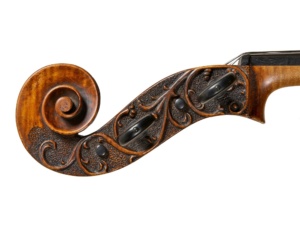
This type of pegbox decoration was common in viols made a century or two earlier in Britain but was rarely seen in violin-family instruments.
Perhaps the most striking feature of this cello is the carving on the sides of the pegbox. The decoration in low relief depicts foliage and vines over a stippled ground. This type of pegbox decoration was common in viols made a century or two earlier in Britain but was rarely seen in violin-family instruments. There are several examples in the Ashmolean Collection with a similar style of ornamentation to the pegbox. The volute is not adorned but is finely carved in the typical violin-family style. Prominent compass points can be seen along the central ridge at the back of the head. The two ridges trailing upwards into the fluting are straight similar to other Fendt instruments. The head appears to be original to the instrument and the varnish matches under UV light. The original ungrafted neck has been extended at the root.
The Hills were big fans of Fendt’s work and would have had good reason to identify him as the maker of this cello. In their business records, they reported many Fendt instruments — cellos in particular — masquerading as old master Italian instruments.
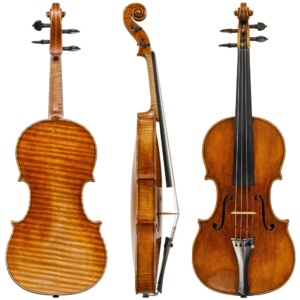
Johann Baptist Schweitzer was the first important Hungarian violin maker. He trained with Franz Geissenhof in Vienna and then returned to Pest in the early 1820s. His work was consistently of a high quality and followed Italian models, passing up the Stainer models favored by his predecessors. Schweitzer’s influence on future generations of Hungarian makers is not to be underestimated. Among his pupils, Samuel Nemessányi, Gabriel Lemböck, Johann Baptist Dvorak and Thomas Zach all went on to have significant careers and make high quality instruments. One unintended and perhaps unwelcome effect of his success is that legions of poor-quality Stradivari model instruments from the late 19th century were given fictitious “Schweitzer” labels. The quality of these trade “Schweitzer” violins is nothing in comparison with the great Hungarian master.
The one-piece back of this handsome violin is made of an attractive flamed maple. The model is a Guarneri pattern from c. 1733-36 freely interpreted in the details:.the edges are too clean, the purfling too narrow and refined and the sound-holes are slightly stiff and the wings flare too much, even for Guarneri. But the overall appearance and presentation is excellent and it’s easy to understand why Schweitzer was so influential over the generations that followed him.
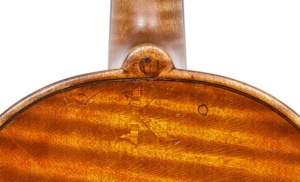
Traces of an insignia on the upper back just below the button – a letter ‘K’?
Of particular interest in this violin are the traces of an insignia on the upper back, just below the button. It appears that some sort of symbol, possibly the letter “K”, was previously inset or carved into the back. It’s unclear if this was added during the maker’s lifetime, but the work to hide the inlay was done later as that area appears under different varnish.
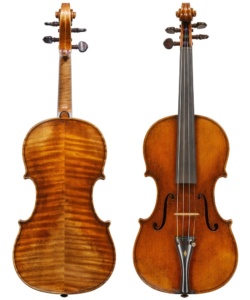
Also in this sale is an attractive Guarneri model violin by another Hungarian maker, Paul Ernst Pilat. Several generations removed from Schweitzer but very much of the same school of making and imitating, Pilat emigrated to New York in 1921 and his work is a bridge between the Hungarian school and the violin makers who flourished in America in the 20th century.
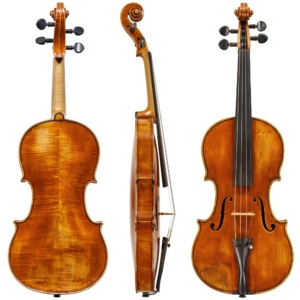
Although it bears a label of Leandro Bisiach dated 1891, this violin is clearly and unmistakably the work of Carlo Carletti made in circa 1920 in Pieve di Cento, a small village outside of Bologna. Carletti and Bisiach were contemporaries, but Bisiach was the big-city maker and dealer and was far more famous and successful in his lifetime. Carletti, who started his career as a carpenter and antiques trader, had the perfect training to make imitations and loosely inspired copies. Of his total output only a small portion of his instruments bear his own label. Many of the instruments he made were copies of 19th and 18th century masters. He also supplied instruments to workshops and dealers such as Bisiach and the Antoniazzi brothers.
This violin, dating from roughly 1920, was probably not intended to be a fake but rather a commission for the Bisiach firm. This arrangement was not uncommon; there were many other makers who made instruments for the Bisiach firm including Iginio Sderci and Bruno Stefanini.
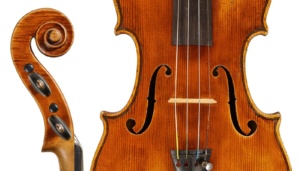
So what makes this the work of Carletti and not Bisiach? Just about everything… The maple is a native Italian maple, not a fancy import. The purfling is heavy on the blacks with maple whites and makes a blunt, but not inaccurate, mitre. The soundholes are slanted with large triangular notches. The varnish is red and slightly shaded. But perhaps the aspect that gives away the maker most is the head: the pegbox is narrow and straight, and the open last turn of the volute ends in a large, rounded eye.
Part of the charm of modern Italian instruments such as those by Carletti is that the strength of their character makes them unmistakable, no matter how they’re labeled. This fine violin is an exceptional example of a maker for whom our appreciation continues to grow.
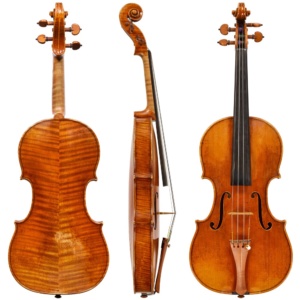
Most of the great contemporary violin makers of our era have defined themselves by the success of their copies of historical instruments. The late 20th and early 21st centuries have seen a renaissance with accomplished makers on all continents mastering the art of imitating the old masters.
Lot 128 in the current auction is a violin made by Gregg Alf in 1994 as a copy of the 1729-30 ‘Lady Streeton’ Guarneri. This is a violin that Tarisio knows well as we sold it in 2013 to its current owner. Although not a ‘bench’ copy, Alf’s violin captures the spirit (and plenty of the sound qualities!) of the original.
The current record for a contemporary violin sold at auction is $132,000 for a violin made by Gregg Alf in 2013. It was tied six years later by Sam Zygmuntovich. Alf’s violin was a 1985 bench copy of the c. 1731 ‘Gibson, Huberman’ Guarneri ‘del Gesù’, which he made especially for Ruggiero Ricci. An earlier violin made by Zygmuntovich in 1994, a copy of the ‘Panette’ Guarneri made for Isaac Stern, holds third place at $130,000.
Without opening the debate about new versus old instruments, I can say that it gives us great pleasure to represent great contemporary makers and to see their work appreciated at auction.
Online bidding is now open. You can view the complete catalogue here.